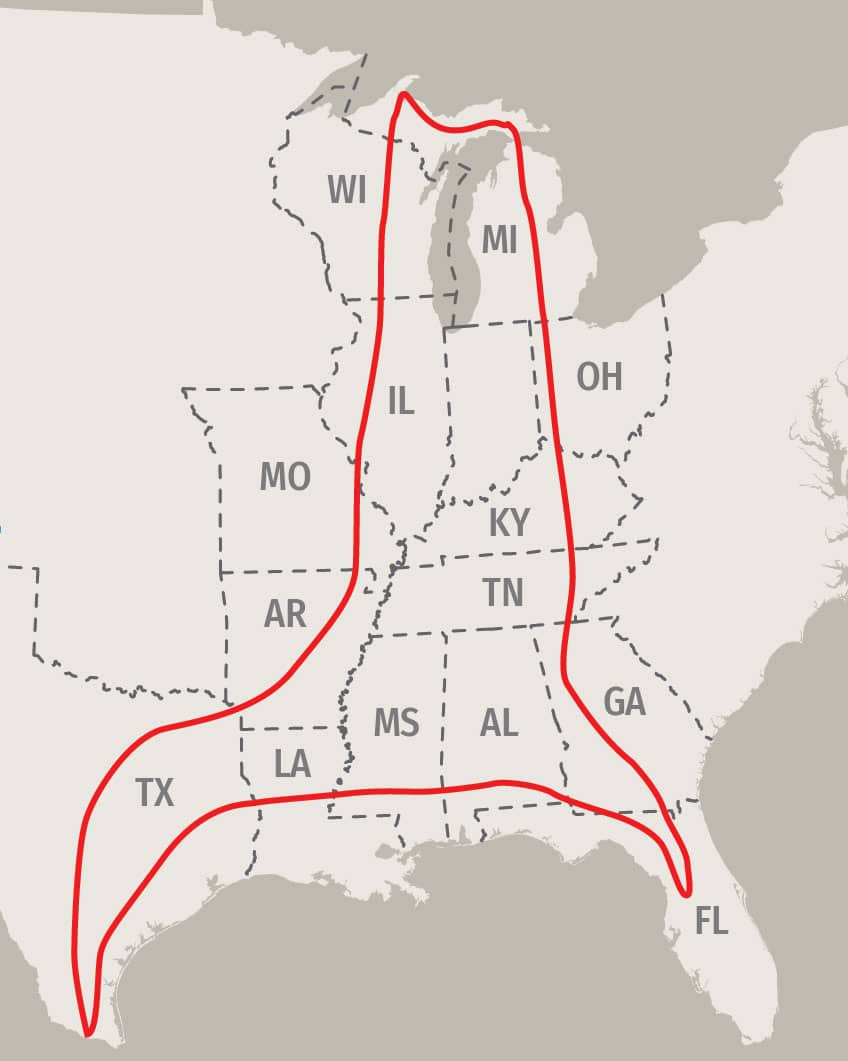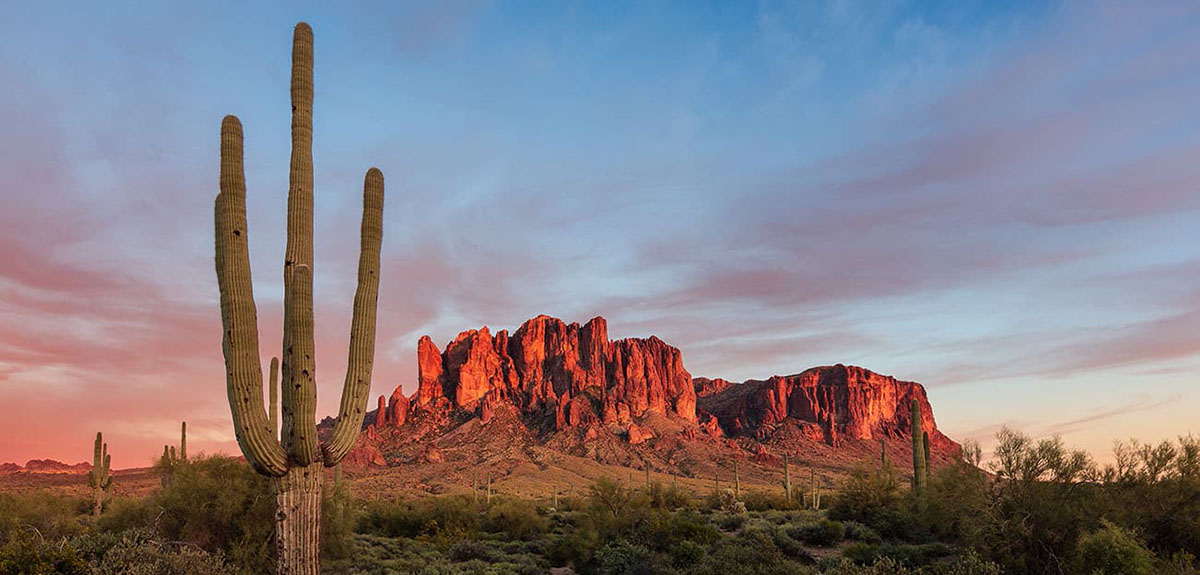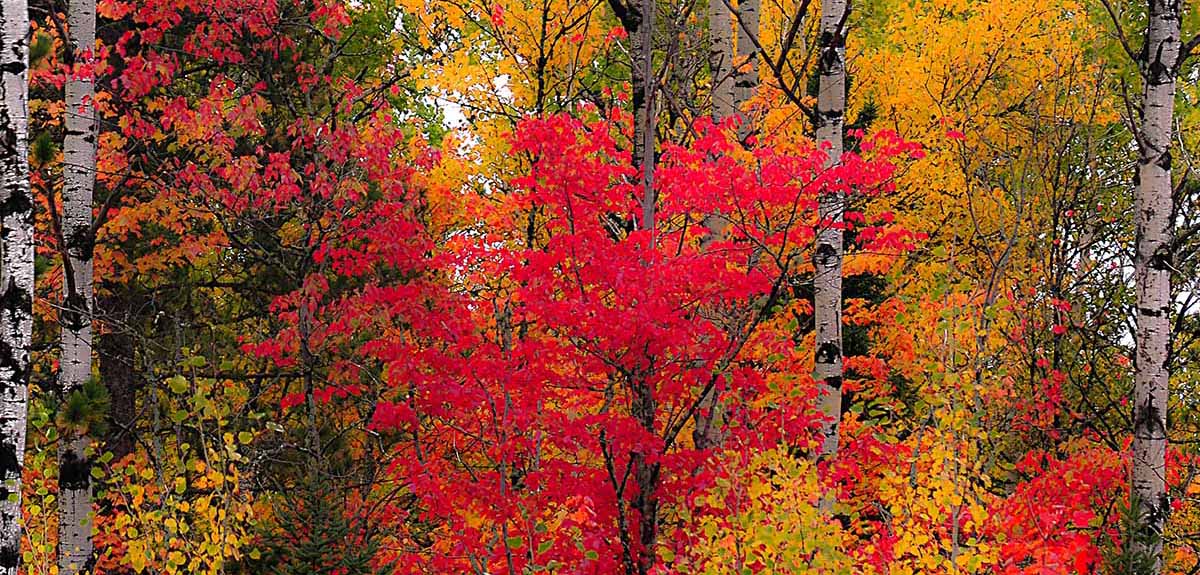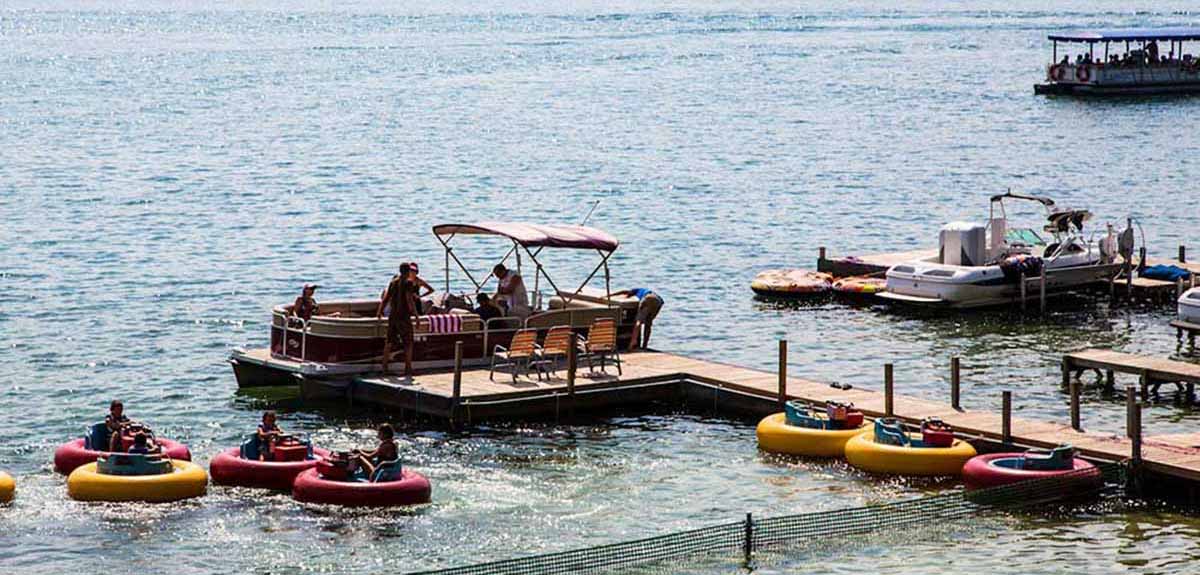Heading South For the Winter: A Snowbird RV Itinerary
Image Caption:
It’s 9 o’clock on a Saturday morning in Eunice, Louisiana, and we’re milling around with a few dozen people, mostly local folks, snacking on boudin (a spicy Cajun sausage) and doughnuts, and sipping strong coffee. Pretty soon some of the musicians in the crowd move to the circle of chairs at the front of the room and begin playing. The sound of fiddles, guitars, a triangle and an accordion fill the air. This is homegrown, authentic Cajun music at its finest.
My wife and I (and our 19-year-old kitty, Zeke) were on a mission of sorts, one that is undertaken by thousands of Northerners annually: escaping the snow and cold of winter. We were spending four months traveling around in our 16-foot Scamp molded-fiberglass travel trailer. The trailer is actually an upgrade for us as we spent two months the previous winter towing a 13-foot Scamp, so the 16-footer seemed huge.
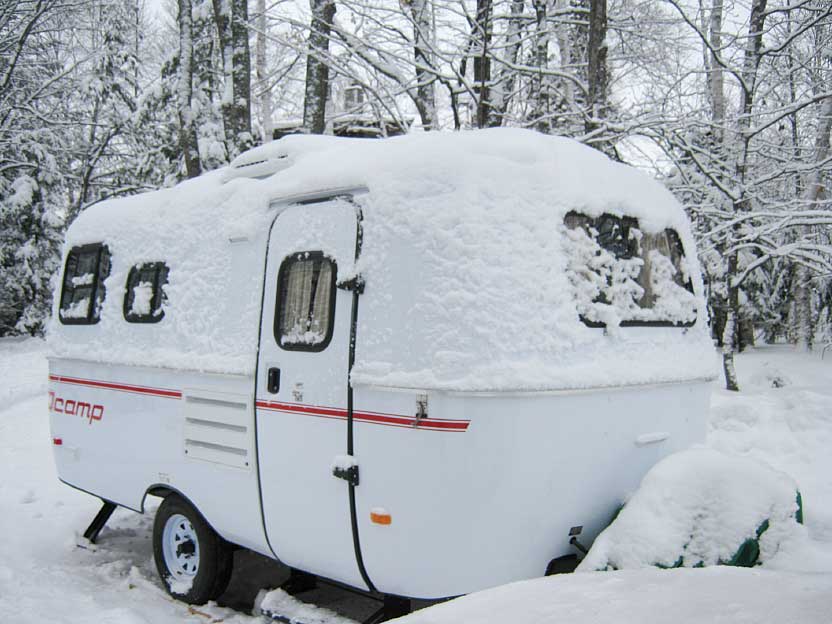
The author’s Scamp covered in snow the day they left for greener pastures.
Michigan to Arkansas
Our journey started last January when we left our home in Michigan’s Upper Peninsula. By the second day, we were camped at the beautiful and nearly deserted Pere Marquette State Park in Grafton, Illinois, a wintering ground for hundreds of bald eagles at the confluence of the Illinois and Mississippi rivers. Hiking trails with fantastic surrounding views as well as the historic lodge make this a great stop. The limestone-and-timber Pere Marquette Lodge was handmade during the Great Depression by the Civilian Conservation Corps. It’s a wonderful building with a 50-foot vaulted ceiling and a 700-ton stone fireplace in the Great Room.
Illinois state park campgrounds are open year-round with electric hookups available at the sites, which is all we need to be comfortable. Our little Scamp has no bathroom, but it serves us well. We have a propane furnace and electric heaters for warmth, a 3.7-cubic-foot refrigerator, a two-burner stove, roof fan, city-water hookup, gray-water tank and plenty more to take care of our basic needs.
Leaving Illinois just as a snowstorm was threatening, we made our way across Arkansas, staying at state parks. We enjoy camping in state parks since they are usually in scenic locations and plenty of outdoor activities are available. An advantage of having a small trailer is that we have our pick of campsites; even sites that are designated as “tent only” will sometimes accommodate us. With our small rig, back-in sites sometimes can be accessed as pull-throughs.
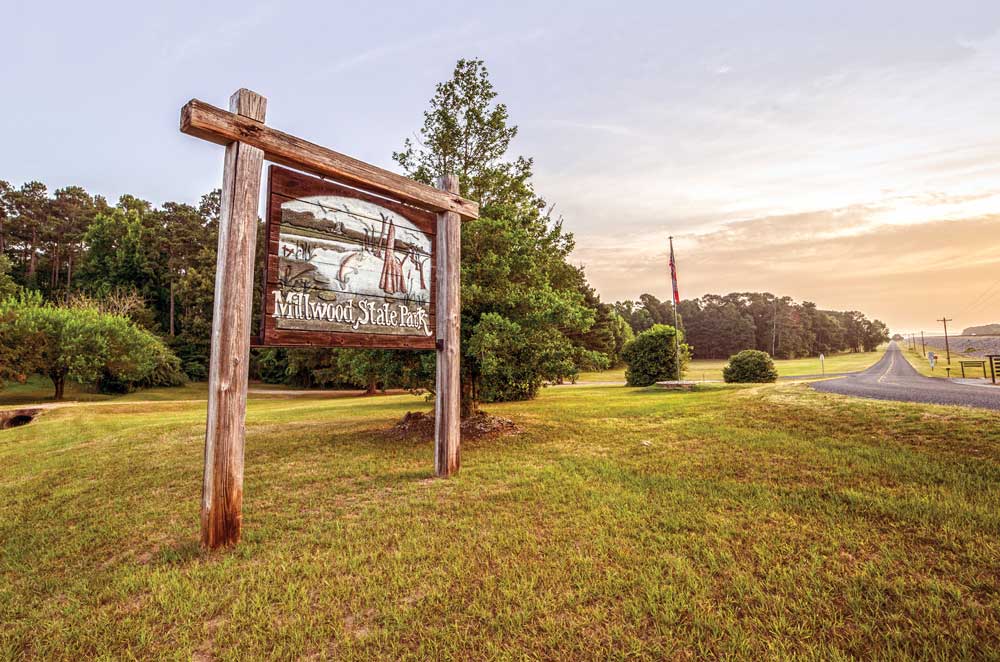
Millwood State Park in Arkansas offers excellent boating and fishing on the adjacent 29,000-acre lake. Photo: Arkansas Department of Parks, Heritage & Tourism
A favorite is Millwood State Park near Ashdown, Arkansas. The park was still recovering from flooding that occurred a few years ago, although it remains a mecca for anglers, having largemouth bass in the 5-to-10-pound range. Birders will also love it here, as the park has been designated an Important Bird Area by the National Audubon Society since nearly three-quarters of the birds known in the state can be found in the vicinity.
Besides the state park, Millwood Lake also boasts seven U.S. Army Corps of Engineers (USACE) RV camping areas. While there, we acted on a tip from the state park superintendent and visited the White Cliffs Natural Area, which is adjacent to a quite nice USACE park. Trails lead past and onto huge chalk cliffs, which are dotted with fossils.
Arkansas to Texas and into Mexico
From there it was onward through Texas, where the lowest price we saw for gas was $1.65 per gallon. When towing a small trailer on long trips like this one, our 2010 Ford Escape V-6 averages around 15 mpg. Towing capacity is 3,500 pounds, and our trailer weighs only about 2,000 pounds loaded. At the private park we stayed at outside the Rio Grande Valley city of Mission, we met people who were traveling in rigs smaller than ours, as well as folks in Class A motorhomes and big fifth wheels, a reminder that RVing is something that can fit most any budget and lifestyle.
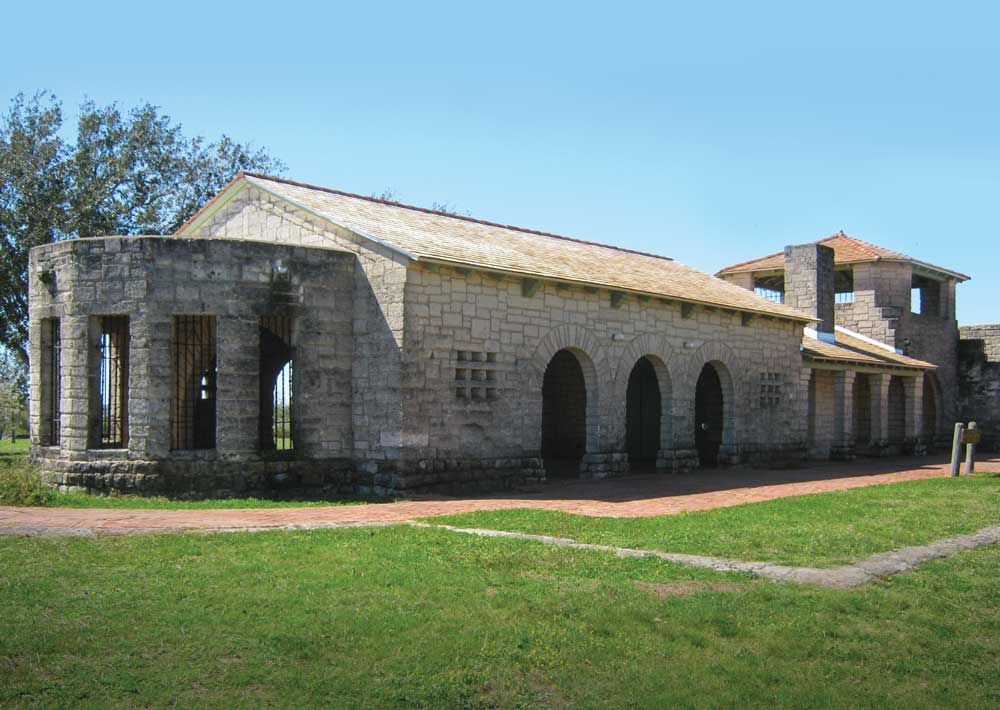
Built by the Civilian Conservation Corps in the 1930s, the Mediterranean-style refectory at Lake Corpus Christi State Park in Mathis, Texas, has a great view from the tower. The 21,000-acre lake is a mecca for swimming, fishing and boating. Photo: Bob Marr
Just down the road from that park is Bentsen-Rio Grande Valley State Park. Although it used to have a campground with RV sites, it is now walk-in only. As a result, there are smooth roads to walk on but no traffic to watch out for. It is known for birding, featuring numerous feeding stations with observation blinds. If you get tired of walking, a tram makes regular circuits of the park.
The Mission-McAllen area has long been known as a snowbird gathering area with countless RV parks of all descriptions. Flea markets and Mexican restaurants abound. One day our friends went with us across the border to Mexico at Nuevo Progreso for a day of sightseeing and shopping. Cheap dental work and prescription drugs are apparently a major draw for U.S. retirees visiting Mexico. We contented ourselves with lunch and a few souvenirs; one of our friends even enjoyed a pedicure.
Leaving the state park, we headed south to visit friends in Florida. Since everything is big in Texas, including driving distances, we stopped at a couple of state parks on our way out. Lake Corpus Christi State Park is a beautiful spot on a large reservoir with fishing, hiking and some very nice campsites, including pull-throughs with full hookups. Our time there was made more special by the fact that we camped in the same site that my wife’s parents stayed in when they visited the park with their Airstream in 1978.
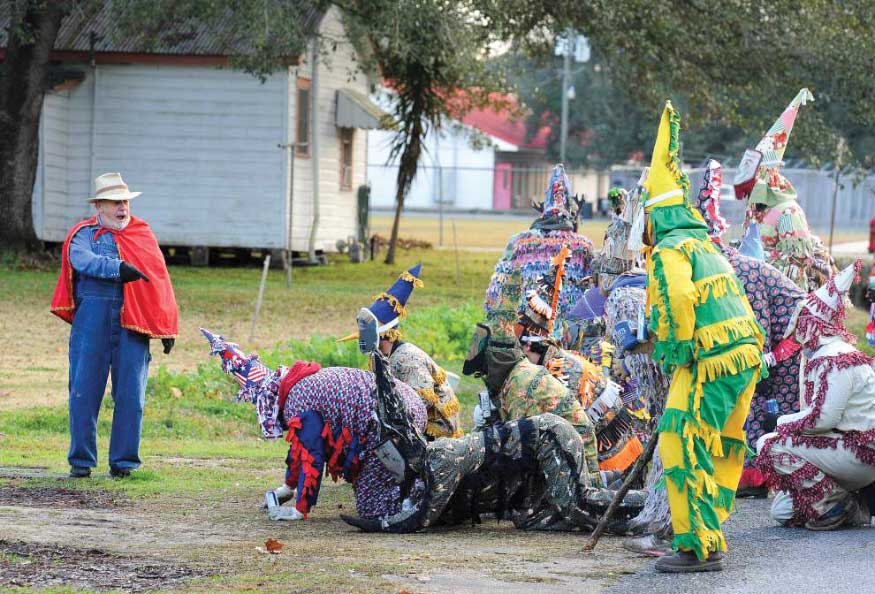
In Evangeline Parish, Louisiana, the town celebrates Mardi Gras Cajun style with costumed locals going from home to home begging for ingredients for a community gumbo. Photo: Darryl Lejeune
Texas to Louisiana and Mardi Gras
This brought us to Chicot State Park near Ville Platte, Louisiana, and our fantastic Mardi Gras experience. We had no idea it was going to be Mardi Gras when making reservations. It was only when we arrived at the park that we realized our good fortune. After dinner in Ville Platte at the highly recommended Café Evangeline, we got to talking with the chef-owner and the director of the local tourist bureau. This area is smack-dab in the middle of Cajun Mardi Gras country, which we were told is very different from the glitzy New Orleans Mardi Gras scene.
The celebrations in this area center around food, family, music, dance and a (to us) rather peculiar custom called the Courir de Mardi Gras. This tradition descends from traditional medieval begging festivals and involves a group of masked and costumed folks on horseback going from house to house and farm to farm asking for ingredients for a communal gumbo pot. If the farmer is willing to donate a chicken, he tosses out a live one, and the participants make a big show of catching it. Each town follows its own version of this tradition, and many have music and dance celebrations as well.
In Eunice we attended the Cajun jam session described at the beginning of this article. Marc Savoy has been playing and building accordions for most of his life. His shop is located in Eunice and is called the Savoy Music Center, a modest-looking building that houses his workshop, musical paraphernalia and, on Saturday mornings from 9 to noon, some of the finest truly authentic Cajun music you will ever hear as folks from near and far gather to play and sing. The jam session here has been going on for more than 40 years, with reportedly only one break while a hurricane passed through. Visitors are welcome; a donation of boudin sausage or a bag of cracklins (deep-fried pork rinds) is suggested.
Chicot State Park in south-central Louisiana is a neat place to camp, with Lake Chicot for fishing and boating, as well as extensive hiking and biking trails and canoeing opportunities. But watch out for alligators! The Louisiana State Arboretum is located within the park and has several trails with lots of signage describing and identifying the native vegetation. Two campgrounds offer nicely wooded sites, and laundry facilities are free; that’s the first time I’ve seen that at a state park.
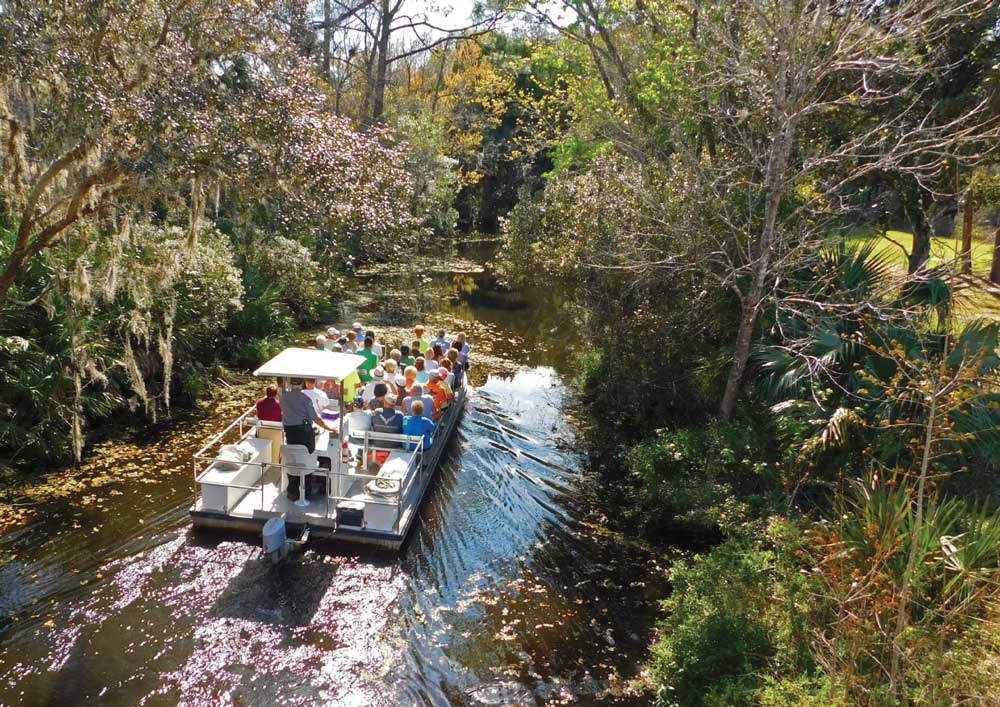
A boat ride at Florida’s Ellie Schiller Homosassa Springs Wildlife State Park takes visitors to the headspring of the Homosassa River. Photo: Miles Saunders
Florida
In Florida we stayed at a private RV park just outside Inverness, located south of Ocala and north of Tampa. The Inverness area has an incredible number of attractions for anyone who enjoys outside activities. For one thing, it is only about 20 miles to the Gulf Coast, where there are a multitude of attractions. One of our favorites was Homosassa Springs Wildlife State Park where it is possible to see hundreds of manatees when the weather conditions are right. It’s also home to the oldest hippopotamus in the United States, Lu, who will be celebrating his 60th birthday this January. Lu is the only non-native animal in the park, which was a private park and zoo until the state took it over in 1990.
The other non-native animals were parceled out to other institutions, but Lu had such a large group of local admirers that then-governor Lawton Chiles made Lu an honorary citizen of Florida so he could remain in the park. Among the native animals that can be seen are alligators, black bears, red wolves and many species of birds. An underwater viewing station makes manatee watching especially fun.
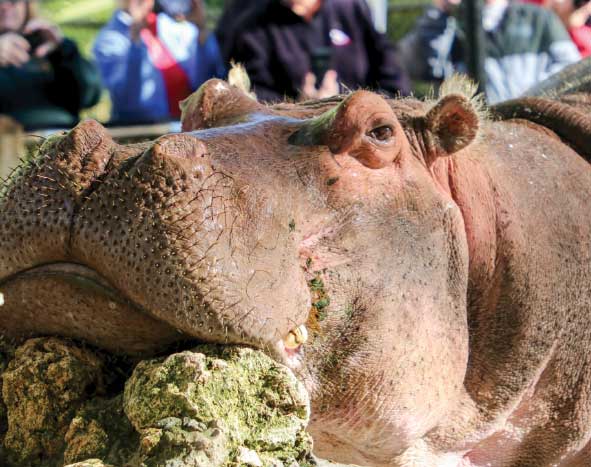
Lu, the oldest hippopotamus in captivity, celebrates his 60th birthday in January 2020 with a special cake and busloads of schoolchildren coming to sing to him at Florida’s Homosassa Springs Wildlife State Park. Photo: Kate Spratt
For hiking enthusiasts, Crystal River Preserve State Park north of Homosassa has several trails, including the Seven Mile Loop Trail, which winds through a variety of coastal habitat types and is a great place for birding and observing wildlife. For something a little more exotic, EARS (Endangered Animal Rescue Sanctuary) near Ocala has around 20 tigers, along with a liger, monkeys, bears and other animals that have been rescued from circuses, private owners and other situations where they could no longer stay. These are all animals that cannot be released back into the wild, so they are given the care and space they need to live out their lives in comfort. Membership tours are held twice a week and are well worth the small fee that is charged.
Fresh seafood abounds, and trying to describe all the wonderful restaurants where we ate is impossible, except to say that summoning up the willpower to cook meals in the trailer was difficult!
Georgia and Tennessee
My webcam at our Michigan home showed that the snow cover was gradually retreating, so in mid-April we slowly headed north since there was no need to hurry. Driving through Georgia, we watched as the “summer” weather of Florida turned back to spring, and when we reached Frozen Head State Park and Natural Area in Tennessee, spring was in full swing with redbud tree blossoms and ephemeral wildflowers in abundance. Named for the highest mountain in the park, Frozen Head is a hidden gem that encompasses 24,000 acres in the Cumberland Mountains.
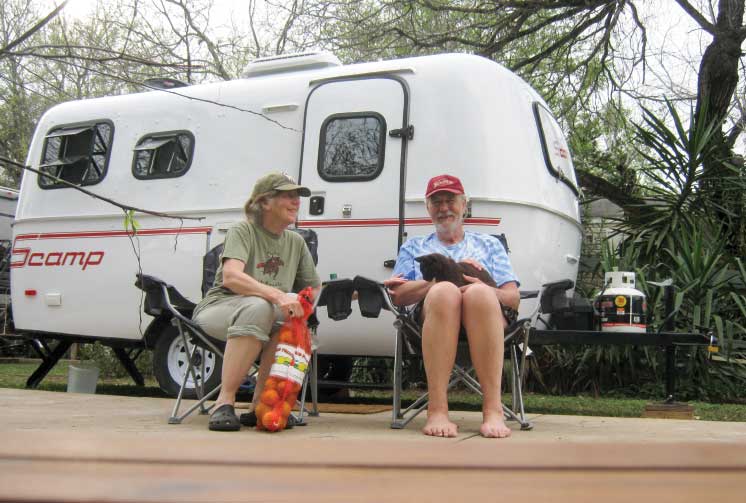
The author and his wife, Janet, with their cat, Zeke, enjoy shorts-and-T-shirt weather on a four-month journey to escape the cold in their 16-foot Scamp. Photo: Bob Marr
Miles upon miles of hiking trails wind up, over and through the mountainous terrain. The campground is nestled right at the base of the mountains. Places like this one are where having a small trailer is a real asset. On the park’s website, the sites are described as “rustic” and “primitive tent campsites.” This is because there are no hookups, not even electric, and a few of them would not even accommodate our Scamp. There is a modern bathhouse with hot and cold running water, showers, drinking water and a dishwashing station, but no dump station. We were probably the largest unit there, but since we can run on battery power for several days, we had no problems. Solar would not be a viable option here with the amount of tree cover.
The rest of our trip home was spent visiting friends and relatives along the way and camping in their driveways. The whole experience was a blast, and we are spending the bulk of this winter on the road again. We encourage anyone to give extended traveling a try, regardless of the size of your RV. We never felt like we lacked for space, and towing such a compact unit was a real pleasure. Good things truly do come in small packages!
Stay and Play
RV accommodations on the author’s 14-state driving route range from national, state and local park campgrounds to privately owned RV parks. The Good Sam website offers a search tool to help find them.
